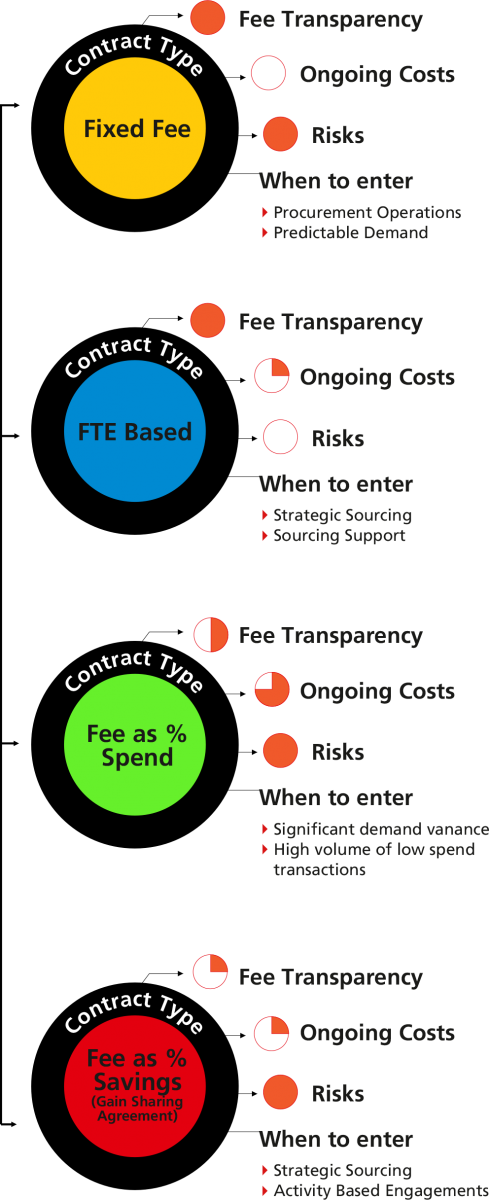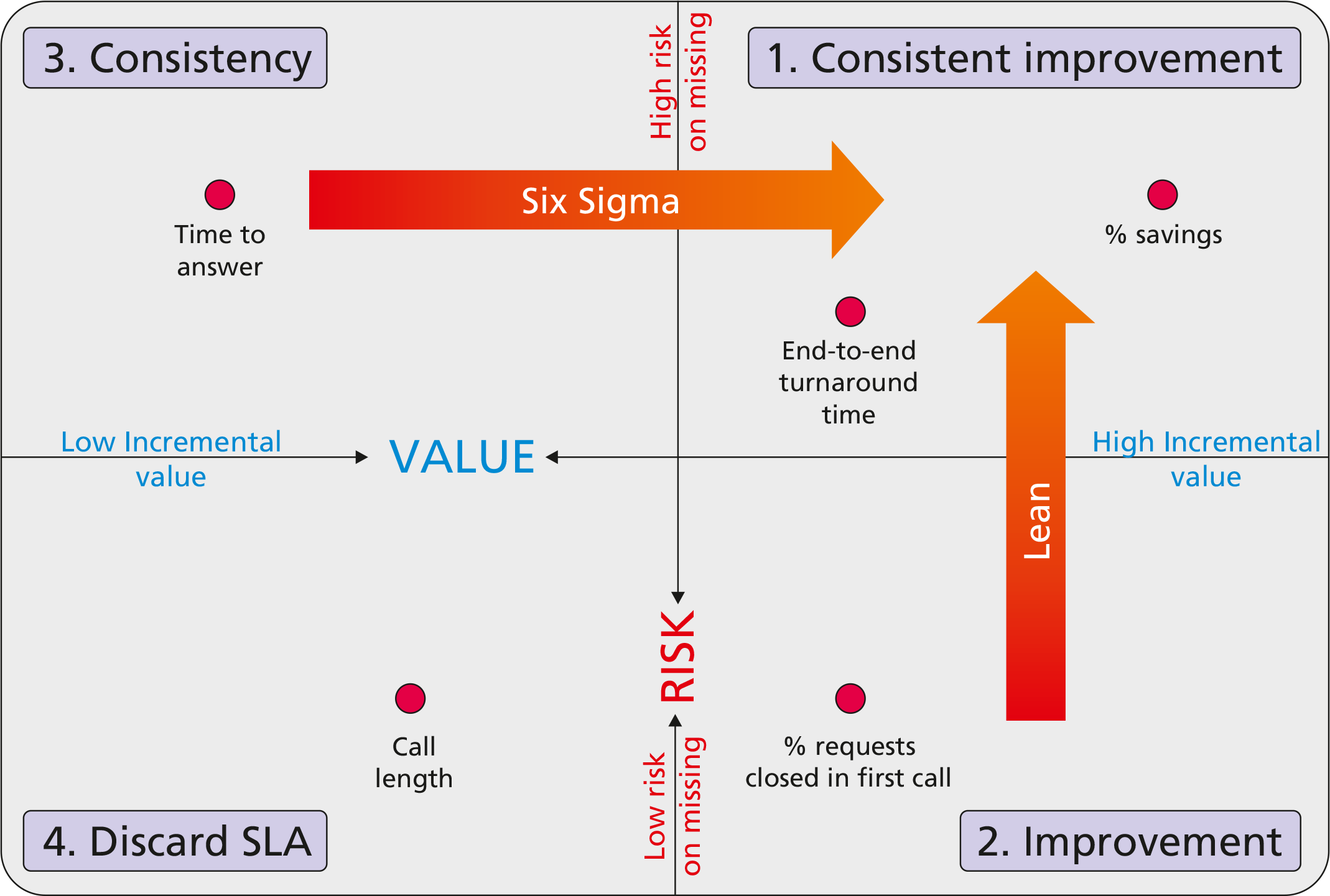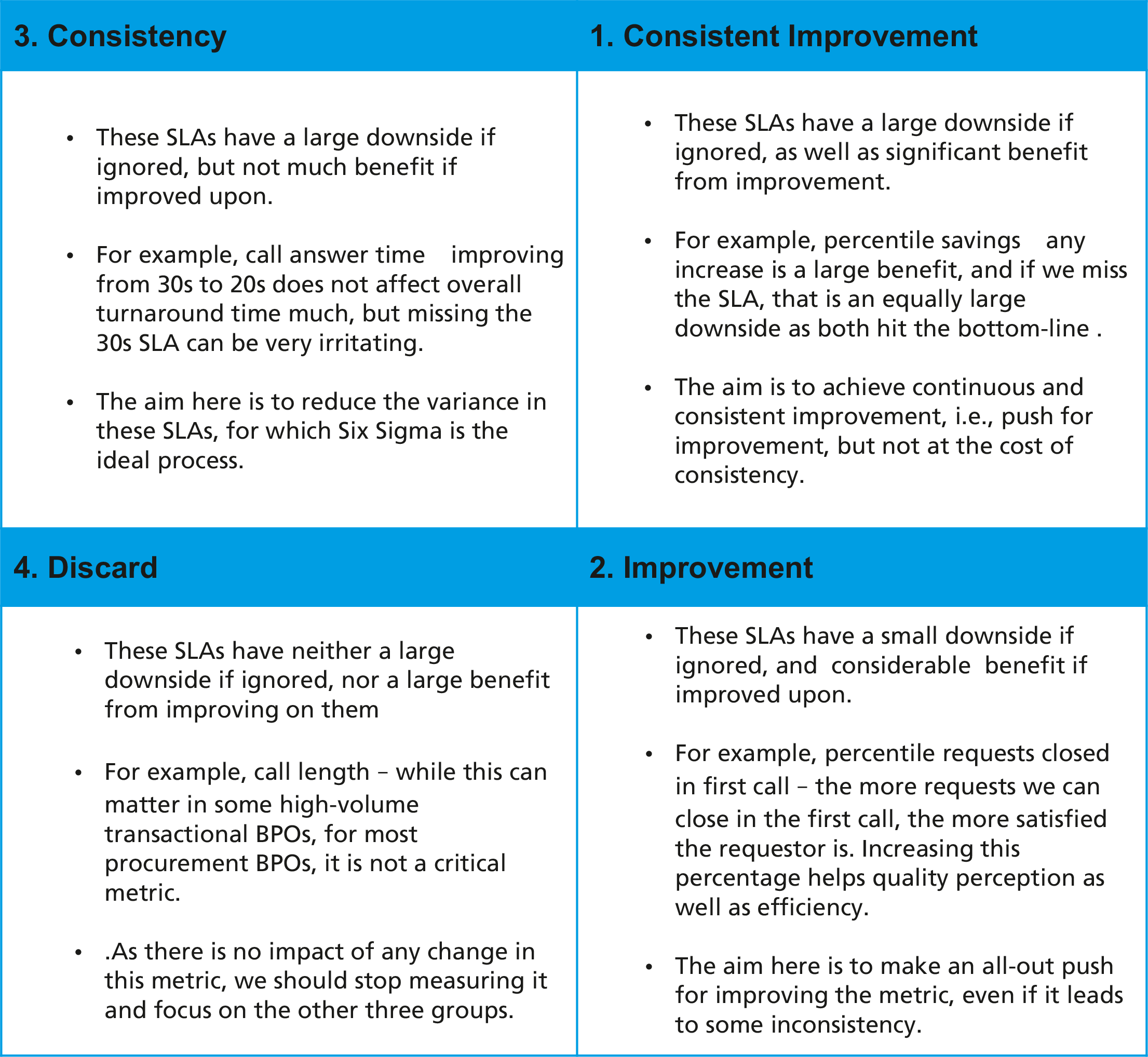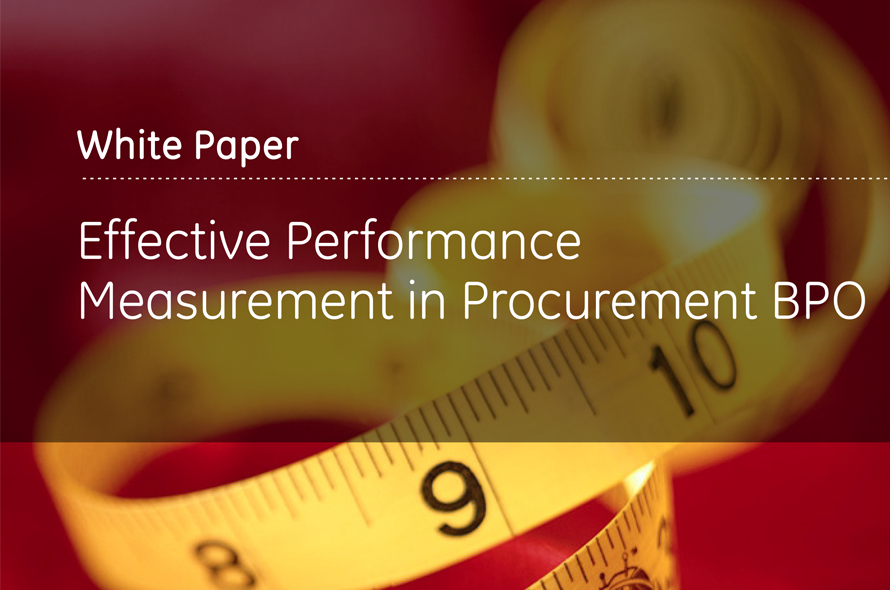Executive Summary
The procurement outsourcing industry is now maturing and procurement is increasingly looked at as a natural candidate for outsourcing. Benefits such as process cost savings, procurement savings, better compliance and diligence are clearly visible, especially in the first year of the engagement. As a result, the question has changed from “Should we outsource this function?” to “How should we best manage this outsourced function?” It has been observed that benefits gained through procurement start eroding year after year without continuous monitoring and improvement initiatives.
Key factors that companies should focus on to continuously improve outsourcing performance are:
- Value realization, which is more important than SLA compliance
- The relationship of procurement successes and mutual accountability
- Incremental innovation
The foundation of a robust, continuously improving process starts with the structure of the contract itself, and continues into the contract execution and monitoring. This white paper aims to address the set-up of a multi-year procurement outsourcing (PO) engagement and the measurement of key metrics therein, highlighting the challenges that companies face in effectively measuring the same. It recommends a staged and iterative approach to measuring and monitoring performance on metrics which are critical to continued benefit realization.
After each improvement cycle, for tangible benefits to show, the SLAs need to be reviewed so as to identify the ones that need improvement next. Only after this can Stage 2 and Stage 3 be started. Through this iterative process, both parties stand to gain efficiencies and improved levels of service that really matter.
Typical Structure of Procurement Contracts
1) SLA-based Fixed Fee Contracts
These are simple and transparent. A key risk to companies entering into long-term contracts with procurement BPO providers is the impact that these vendors have on the existing processes. A logical derivative is a fixed fee contract with penalties for missing SLAs. Such a contract is defensive and does not provide incentives for the supplier to continuously improve the process. Also, these agreements are not robust against demand variability.
2) FTE-based (Time and Material) Contracts
These are also simple contracts, but require an increased level of monitoring from the company. They are ideal for cases where the demand variability is very high, as in sourcing support and strategic sourcing. They lack the incentives for the supplier to continuously improve the process.
3) Spend-tied Contracts (where the fees of the outsourced provider depend on the managed spend)
Spend-tied agreements do not offer clear transparency upfront in supplier fees. However, in cases where there is a high number of low volume transactions with significant demand variance, the supplier fees can easily be traced back to the volume processed. Though the upfront investment in these deals is low, ongoing costs can be higher. As the supplier fees are not tied to clear targets on value realized, the risk of a company paying the supplier for transaction processing without any significant value significantly increases.
4) Gain-sharing Agreements (wherein total fee depends on amount of savings the provider brings in)
These are perceived as the least transparent contracts. In a recent study carried out by Procurement Leaders, it was found that about 65 percent of respondents were unable to measure the financial return of indirect procurement BPO services. However, in our view, these contracts also lay the groundwork and incentives for the procurement BPO vendor to continuously improve the process and realize tangible gains from the same.
Based on the table below, the contract structure or blend of structures should be selected.

What Are the Service Level Agreements When Engaging a Procurement BPO Firm?
The service level agreements (SLAs) are agreements on key metrics that would be measured to evaluate performance of a supplier. SLAs vary, depending on the nature of the procurement outsourcing deal, and provide a common ground for periodic communication with the customers. The method of measurement of the SLA should be taken into account for calculating the value realized by the customer in terms of reduced costs. SLAs should be periodically reviewed to ensure relevance, based on changing business situations. Unfortunately, many clients simply measure everything that can be measured, resulting in exhaustive reports in which key metrics get lost. Different SLAs require different treatments, as shown below:

The above framework helps us determine which SLAs are relevant, which ones should be held steady and which ones should be improved upon. There are two dimensions along which an SLA can be useful:
- Incremental value derived from improving on that SLA, for example, increase in savings percentage is direct value realized.
- Risk associated with missing the SLA, for example, unpredictable turnaround time can hold up business.

In Summary
It is important to note that not all SLAs add value. The supplier, as well as client resources, is best utilized by selecting the right concise set of metrics, and then classifying them into ones where improvement will yield value versus ones where consistency will yield value. It is important to know what end-result we are trying to influence by measuring each SLA.
Lean for Improvement SLAs
The Lean framework identifies the sources of wastage and recommends measures to eliminate them, thereby improving process efficiency and quality. As noted in the previous section, the SLAs in the “Improvement” and “consistent improvement” quadrants need to be examined under lean principles.
Assumptions:
- The Supplier for the product has been selected through a rigorous sourcing process and the customer already has a contract with the Supplier
- TPC is the time taken by procurement to fill a PO for a product
- TTOT is the total time between when a requisition is raised by a requisitioner to PO receipt by the product
Total Operational Cycle Time =
Time Towards Value Added Activity (filling a PO) + Time Spent on Non-Value Added Activities (Time Takento Assign Request to a Buyer + Time Taken by Buyer to transfer data from Requisition to PO + Time Taken to Review the PO Information + Time Taken to Approve the PO + Time Taken to Send PO to the Supplier).
Investments in expanding the scale of Procurement Outsourcing team usually involve increasing the team size and thereby focus upon reduction in TPC. However, the goal of Lean is to reduce the Total Operational Cycle Time (TTOT) by reducing the time taken for non-value adding activities and thereby eliminating any source of waste. Time on non- value added activities be reduced through a preset rules (either in the system or manually) wherein a map of business unit to Buyer is created and implemented, to reduce the Time Taken to Assign Request to a Buyer.
Similarly time to transfer data from requisition to PO could be eliminated through technology implementation or through a guide on mapping requisition data to the PO form (eg. Field 1 on Requisition should be filled into Field A of the PO form).
Identification of sources of waste and their elimination should be an iterative process and improvement in operational cycle time with each process change should be measured to evaluate the overall effectiveness of the continuous improvement initiative.
Six Sigma for Consistency SLAs
The Six-Sigma framework focuses on reducing process variability by reducing defects in identified opportunities. For instance, if the SLA for “average time to answer calls” is 20 seconds, then both scenarios below yield results within the defined SLAs, but Scenario A has higher process variability than scenario B.

The above process variability would lead to a bullwhip effect and could cause downstream impact on customer satisfaction or could result in increased operational cycle time. Identifying the above opportunities and devising methods to reduce defects (eg, A takes 13 seconds more than the required SLA to answer the customer call) will result in reduced process variability and, thereby, positively impact downstream processes.
In this specific example, training Associate A on the systems or processes, or even training the end-user on providing required information to the helpdesk associate could reduce the “defect” rate.
Assuming the total number of associates to be three, the number of tickets raised by the helpdesk associate as four, the opportunities in the above example would be as follows:

When the process variability is reduced to ensure that there are 3.4 defects per million identified opportunities, the process is said to meet the Six Sigma standards.
Similar to Lean, Six Sigma is a continuous improvement framework and involves iteratively identifying opportunities and measuring the defects.
Case study on Continuous Improvement - Procurement Hub
Client: A fortune 500 global company was having problems getting employees to comply with policies and follow procurement direction including ordering processes and standardizing their P2P operations. The company was not meeting its targets on various metrics, including spend percentile with approved vendors. Employees complained that the P2P process was not standardized and they did not know how long anything would take.
GEP focused on the procurement department's communication, delivery modes, and the various compliance checks. The problem was defined and baseline metrics identified. The company's procurement website was one webpage with links to the policies and a link to send an email if the employee had any questions. GEP built a refreshed procurement hub encased in concise SLAs. The new, robust portal ultimately housed:
1) Department and category-specific policies, including category profiles and “how to buy”
2) Links to specific technologies to instantly help the employee place the order
3) Procedures and training documentation to walk the employee through the ordering processes
4) FAQs with search capability
5) Easy ways to contact procurement for help including help desk contact info and instant web chat
6) All transactional activities routed through help desk, and monitored by a ticketing system with metrics
Under the new direction from procurement and the enhanced procurement hub, the company experienced instant compliance increases some regions up to 50% within a matter of a few weeks. These changes were measured and reported back to the organization, leading to a second wave of awareness and interest. Within the next two months, the resolution times continued to improve with central monitoring.

